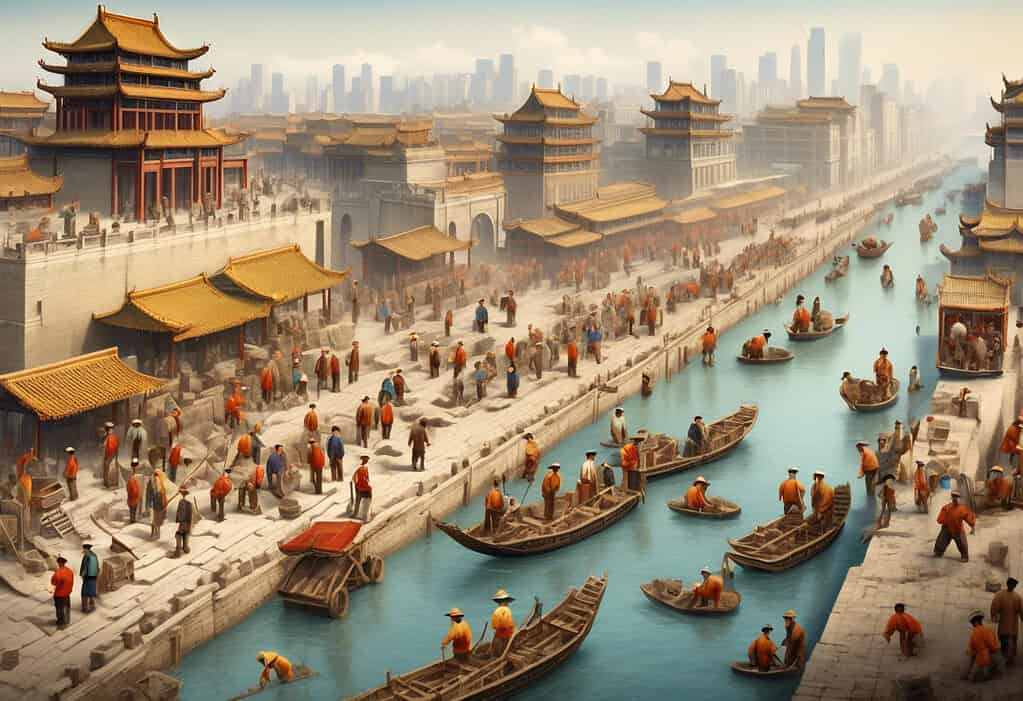The Sui Dynasty ruled China from 581 to 618 CE. It was a time of significant changes and accomplishments in Chinese history. The dynasty was founded by Emperor Wen and his son Emperor Yang. They unified China after centuries of division and laid the foundation for the following Tang Dynasty. The Sui Dynasty is known for its construction of the Grand Canal, which connected the Yellow River and the Yangtze River, facilitating trade and transportation. The dynasty also implemented reforms in government administration, military organization, and legal system. Despite its short duration, the Sui Dynasty left a lasting impact on Chinese history and culture.
Summary List
- The Sui Dynasty ruled China from 581 to 618 CE.
- It was founded by Emperor Wen, who reunified China after centuries of division.
- The Sui Dynasty is known for its construction projects, including the Grand Canal and the rebuilding of the Great Wall.
- Emperor Yang of Sui was a controversial ruler known for his extravagant lifestyle and harsh policies.
- The Sui Dynasty ended in 618 CE when Emperor Yang was assassinated, leading to the rise of the Tang Dynasty.
Games And Apps
Learning Modules
Founding of the Sui Dynasty - 581 CE
In 581 CE, the Sui Dynasty was founded in China, marking the end of the chaotic Northern and Southern Dynasties period. Led by Emperor Wen, the Sui Dynasty brought stability and unity to the region, laying the foundation for the powerful Tang Dynasty that would follow.
I Want To Learn This!Construction of the Grand Canal - 605 CE
In 605 CE, the construction of the Grand Canal began under the Sui Dynasty in China. This monumental project spanned over 1,100 miles, connecting the Yellow River and Yangtze River. The canal facilitated transportation of goods, cultural exchange, and boosted economic development in the region.
I Want To Learn This!The Northern Expeditions - 604-610 CE
Embark on a thrilling journey through the harsh landscapes and treacherous waters of the Arctic in The Northern Expeditions - 604-610 CE. Follow a group of brave explorers as they push the boundaries of human endurance in search of new lands and untold riches. Will they conquer the frozen wilderness or fall victim to its icy grip?
I Want To Learn This!The Fall of the Chen Dynasty - 589 CE
In 589 CE, the powerful Chen Dynasty fell after a series of internal conflicts and external invasions. The once-mighty empire crumbled under the weight of political turmoil and military defeats, marking the end of an era and the beginning of a new chapter in Chinese history.
I Want To Learn This!The Completion of the Great Wall - 606 CE
In 606 CE, Emperor Yang of the Sui Dynasty completed the construction of the Great Wall of China, a monumental feat of engineering that spanned over 13,000 miles. This historic event marked the end of a centuries-long project to fortify the northern borders and protect the empire from invasion.
I Want To Learn This!The Sui-Tang War - 610-614 CE
The Sui-Tang War of 610-614 CE was a pivotal conflict in Chinese history, marking the transition from the Sui dynasty to the Tang dynasty. Fought between the forces of Emperor Yang of Sui and the rebel leader Li Yuan, the war resulted in the establishment of the Tang dynasty and a new era of prosperity in China.
I Want To Learn This!The Rebellion of Li Mi - 613 CE
In 613 CE, Li Mi led a daring rebellion against the ruling Sui Dynasty in China. With a band of loyal followers, he challenged the oppressive regime and sparked a revolution that would change the course of history. The Rebellion of Li Mi is a gripping tale of courage, betrayal, and redemption.
I Want To Learn This!The Death of Emperor Yang - 618 CE
In 618 CE, the powerful and controversial Emperor Yang of the Sui Dynasty met his demise in a dramatic and mysterious fashion. Amidst political intrigue, betrayal, and rebellion, the death of Emperor Yang marked a turning point in Chinese history, leading to the fall of the Sui Dynasty and the rise of the Tang Dynasty.
I Want To Learn This!The Sui Dynasty's Military Reforms - 589-618 CE
The Sui Dynasty's military reforms from 589-618 CE were instrumental in transforming the Chinese army into a powerful and efficient force. These reforms included the creation of a professional standing army, improved training methods, and the implementation of new military technologies, leading to significant victories and territorial expansion.
I Want To Learn This!The Rise of Buddhism in the Sui Dynasty - 581-618 CE
The Sui Dynasty saw a significant rise in Buddhism, with Emperor Wen actively promoting the religion and building grand temples. Buddhist scriptures were translated into Chinese, leading to a surge in popularity among the people. This period marked a turning point in the spread of Buddhism in China.
I Want To Learn This!












